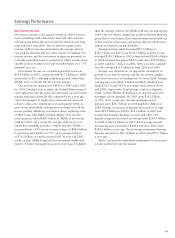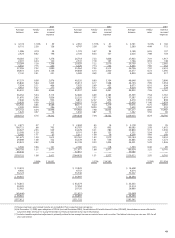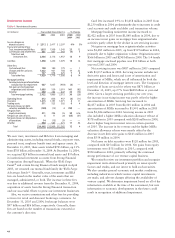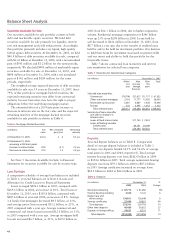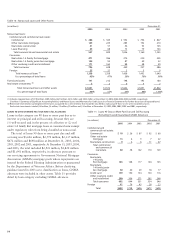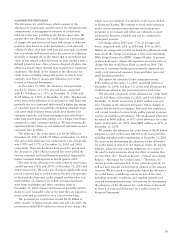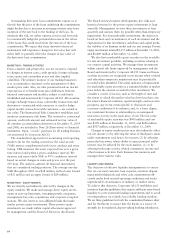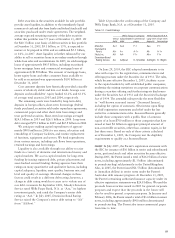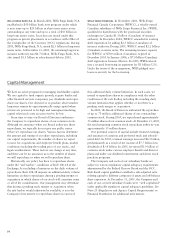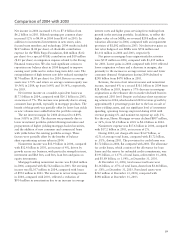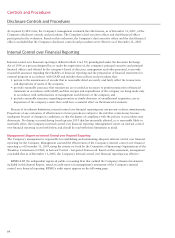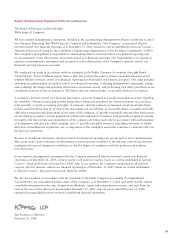Wells Fargo 2005 Annual Report Download - page 51
Download and view the complete annual report
Please find page 51 of the 2005 Wells Fargo annual report below. You can navigate through the pages in the report by either clicking on the pages listed below, or by using the keyword search tool below to find specific information within the annual report.
49
Credit Risk Management Process
Our credit risk management process provides for decentral-
ized management and accountability by our lines of business.
Our overall credit process includes comprehensive credit
policies, frequent and detailed risk measurement and model-
ing, extensive credit training programs and a continual loan
audit review process. In addition, regulatory examiners
review and perform detailed tests of our credit underwriting,
loan administration and allowance processes.
Managing credit risk is a company-wide process. We have
credit policies for all banking and nonbanking operations
incurring credit risk with customers or counterparties that
provide a consistent, prudent approach to credit risk man-
agement. We use detailed tracking and analysis to measure
credit performance and exception rates and we routinely
review and modify credit policies as appropriate. We have
corporate data integrity standards to ensure accurate and
complete credit performance reporting. We strive to identify
problem loans early and have dedicated, specialized collec-
tion and work-out units.
The Chief Credit Officer, who reports directly to the
Chief Executive Officer, provides company-wide credit over-
sight. Each business unit with direct credit risks has a credit
officer and has the primary responsibility for managing its
own credit risk. The Chief Credit Officer delegates authority,
limits and other requirements to the business units. These
delegations are routinely reviewed and amended if there are
significant changes in personnel, credit performance, or busi-
ness requirements. The Chief Credit Officer is a member of
the Company’s Management Committee.
Our business units and the office of the Chief Credit
Officer periodically review all credit risk portfolios to ensure
that the risk identification processes are functioning properly
and that credit standards are followed. Business units con-
duct quality assurance reviews to ensure that loans meet
portfolio or investor credit standards. Our loan examiners
and internal auditors also independently review portfolios
with credit risk.
Our primary business focus in middle-market commercial
and residential real estate, auto and small consumer lending,
results in portfolio diversification. We ensure that we use
appropriate methods to understand and underwrite risk.
In our wholesale portfolios, larger or more complex loans
are individually underwritten and judgmentally risk rated.
They are periodically monitored and prompt corrective
actions are taken on deteriorating loans. Smaller, more
homogeneous loans are approved and monitored using
statistical techniques.
Retail loans are typically underwritten with statistical
decision-making tools and are managed throughout their life
cycle on a portfolio basis. The Chief Credit Officer establishes
corporate standards for model development and validation
to ensure sound credit decisions and regulatory compliance.
Each business unit completes quarterly asset quality fore-
casts to quantify its intermediate-term outlook for loan losses
and recoveries, nonperforming loans and market trends. To
make sure our overall allowance for credit losses is adequate
we conduct periodic stress tests. This includes a portfolio loss
simulation model that simulates a range of possible losses
for various sub-portfolios assuming various trends in loan
quality. We assess loan portfolios for geographic, industry,
or other concentrations and use mitigation strategies, which
may include loan sales, syndications or third party insurance,
to minimize these concentrations, as we deem necessary.
We routinely review and evaluate risks that are not
borrower specific but that may influence the behavior of a
particular credit, group of credits or entire sub-portfolios. We
also assess risk for particular industries, geographic locations
such as states or Metropolitan Statistical Areas (MSAs) and
specific macroeconomic trends.
NONACCRUAL LOANS AND OTHER ASSETS
Table 10 shows the five-year trend for nonaccrual loans
and other assets. We generally place loans on nonaccrual
status when:
• the full and timely collection of interest or principal
becomes uncertain;
• they are 90 days (120 days with respect to real estate
1-4 family first and junior lien mortgages) past due for
interest or principal (unless both well-secured and in
the process of collection); or
• part of the principal balance has been charged off.
Note 1 (Summary of Significant Accounting Policies) to
Financial Statements describes our accounting policy for
nonaccrual loans.
The decrease in nonaccrual loans was primarily due
to payoffs of commercial and commercial real estate
nonaccrual loans.
We expect that the amount of nonaccrual loans will
change due to portfolio growth, portfolio seasoning, routine
problem loan recognition and resolution through collections,
sales or charge-offs. The performance of any one loan can
be affected by external factors, such as economic conditions,
or factors particular to a borrower, such as actions of a
borrower’s management.
If interest due on the book balances of all nonaccrual
loans (including loans that were but are no longer on nonac-
crual at year end) had been accrued under the original terms,
approximately $85 million of interest would have been
recorded in 2005, compared with payments of $35 million
recorded as interest income.
Most of the foreclosed assets at December 31, 2005, have
been in the portfolio one year or less.
Risk Management




